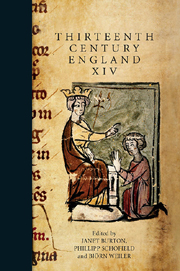Book contents
- Frontmatter
- Contents
- List of Figures and Tables
- Preface
- List of Contributors
- List of Abbreviations
- Politics and the People in Thirteenth-Century England
- Peasants, Litigation and Agency in Medieval England: the Development of Law in Manorial Courts in the late Thirteenth and Early Fourteenth Centuries
- Medieval Accounting Memoranda from Norwich Cathedral Priory
- The Seals of London's Governing Elite in the Thirteenth Century
- The Marriages of the English Earls in the Thirteenth Century: a Social Perspective
- Monks and Politics in Thirteenth-Century Wales and Catalonia
- Lope Fernández, Bishop of Morocco: His Diplomatic Role in the Planning of an Anglo-Castilian Crusade into Northern Africa
- On Kingship and Tyranny: Grosseteste's Memorandum and its Place in the Baronial Reform Movement
- St Edmund of Canterbury and Henry III in the Shadow of Thomas Becket
- Matthew Paris and the Royal Christmas: Ritualised Communication in Text and Practice
- Thomas of Lancaster in the Vita Edwardi Secundi: a Study in Disillusionment
- John and Henry III in the Anglo-Norman Prose Brut
- Genealogiae orbiculatae: Matthew Paris and the Invention of Visual Abstracts of English History
- The Genealogical Chronicles of Matthew Paris: Edition
Monks and Politics in Thirteenth-Century Wales and Catalonia
Published online by Cambridge University Press: 05 May 2013
- Frontmatter
- Contents
- List of Figures and Tables
- Preface
- List of Contributors
- List of Abbreviations
- Politics and the People in Thirteenth-Century England
- Peasants, Litigation and Agency in Medieval England: the Development of Law in Manorial Courts in the late Thirteenth and Early Fourteenth Centuries
- Medieval Accounting Memoranda from Norwich Cathedral Priory
- The Seals of London's Governing Elite in the Thirteenth Century
- The Marriages of the English Earls in the Thirteenth Century: a Social Perspective
- Monks and Politics in Thirteenth-Century Wales and Catalonia
- Lope Fernández, Bishop of Morocco: His Diplomatic Role in the Planning of an Anglo-Castilian Crusade into Northern Africa
- On Kingship and Tyranny: Grosseteste's Memorandum and its Place in the Baronial Reform Movement
- St Edmund of Canterbury and Henry III in the Shadow of Thomas Becket
- Matthew Paris and the Royal Christmas: Ritualised Communication in Text and Practice
- Thomas of Lancaster in the Vita Edwardi Secundi: a Study in Disillusionment
- John and Henry III in the Anglo-Norman Prose Brut
- Genealogiae orbiculatae: Matthew Paris and the Invention of Visual Abstracts of English History
- The Genealogical Chronicles of Matthew Paris: Edition
Summary
Monasteries and politics tend to be inseparable in medieval history. However close religious communities sought to get to a complete withdrawal from the clamours of the immoral and decadent world outside, ultimately they all sprang from this world and its society. And with this society, religious men and women, a few remarkable and much admired exceptions aside, continued to associate and be associated – and involved in its crises, be they social, economic or political.
Richard Southern once remarked that ‘the history of the medieval church is the history of medieval society’, explaining that
everywhere in the history of the religious orders we find that associations which were founded as a protest against the world and all its ways had their destinies shaped for them by the society in which they had their being. There were many forces which shaped them, even against their will: their property, their family connexions, their secular functions, and the opportunity which they offered their members for advancement to the highest places in the social order.
I want to focus here on the second and penultimate points, the family connections and what Southern calls the ‘secular functions’ of religious orders, or rather on certain aspects thereof, and I will do so by looking at two regions, which present an interesting case for comparison, particularly in the thirteenth century, namely Wales and Catalonia. I will look at ways in which religious communities might become drawn into the politics of their times and consider the consequences, both direct and indirect, this may have had for the lives of their members; lives according to certain rules and regulations and under certain vows, which in theory anticipated a very different response and commitment than we often find in practice.
- Type
- Chapter
- Information
- Thirteenth Century England XIVProceedings of the Aberystwyth and Lampeter Conference, 2011, pp. 87 - 100Publisher: Boydell & BrewerPrint publication year: 2013

